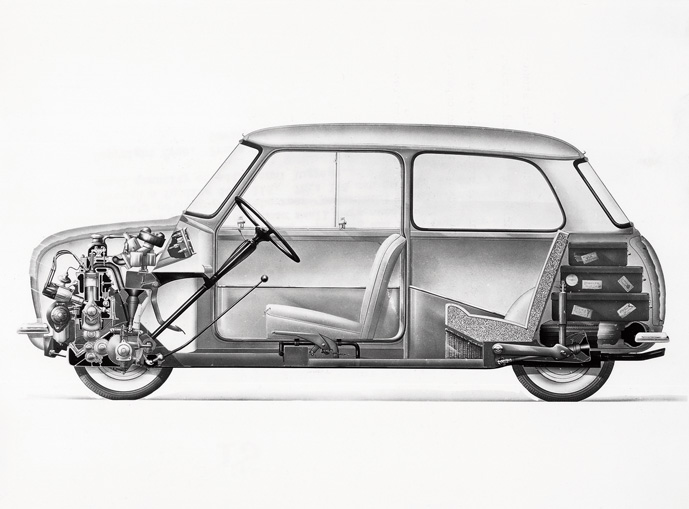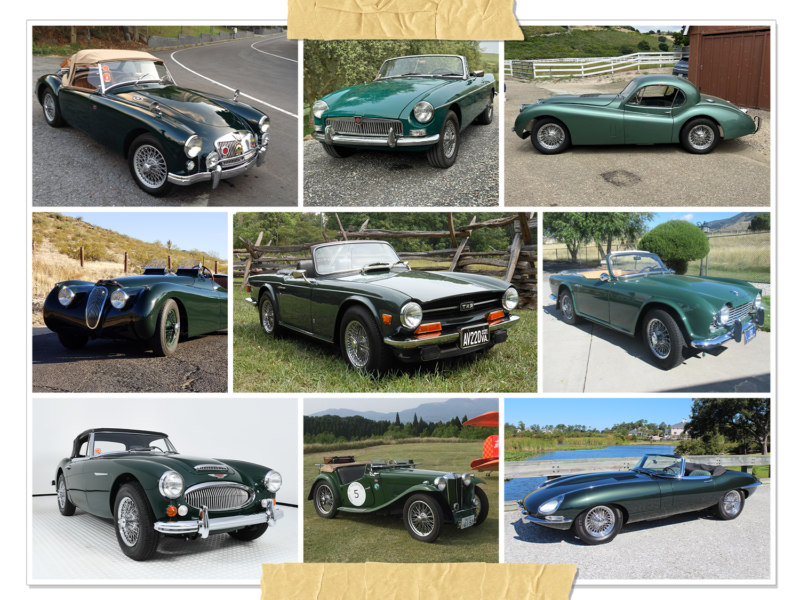Car owners have always loved vehicles that seem to smile. That’s one reason why the Mini was one of the most successful automobiles of all time, but there are plenty more reasons too. It’s easy to upgrade performance and customize appearance, it has cachet and it’s a blast to drive. No wonder 5.3 million Minis were sold worldwide over 41 years of production!
Through the years, the Mini evolved in physical form, engineering and aesthetics. Model variations ranged from vans and pickups to long-wheelbase versions. Engineering advances such as fuel injection and catalytic converters were added over time, and performance models were introduced.
From an aesthetics perspective, the factory launched upscale models with an elegant front grille and modern front end; Italian firm Innocenti built luxury versions under license from British Motor Cars; and aftermarket suppliers developed accessories to personalize Minis in infinite and quirky ways.
In other words, there’s a Mini out there to suit your desires, and a zillion ways to enhance performance and make it your own.

The sales literature said the Mini could hold four people and their luggage, but sometimes people had to get creative.
The Mini Revolution
British Motor Cars developed the Mini as an economical, entry-level car that challenged the popularity of the Volkswagen Beetle. It was considered revolutionary when it launched in 1959 with a compact layout, transversely mounted engine and front-wheel drive. It offered both performance (top speed 70 mph) and frugality (fuel consumption 50 mpg).
Although the original 848cc engine produced just 37 horsepower, Mini’s light weight (1,400 pounds) and short wheelbase (80 inches) meant it was fast, nimble and quick cornering. The fully independent suspension used rubber cones as both shock absorbers and springs, supplying go-kart-like handling. Signifying features on these Mark I models, made from 1959 through 1967, are external door hinges, sliding front side windows and 10-inch-diameter wheels.

“So many people bought these cars because they were cute, but didn't pay attention to exactly what they were buying,” says Kelvin Dodd.
Coopers Earn Acclaim
The first performance-tuned Mini was developed by Formula 1 car builder John Cooper. The Mini Cooper was introduced in 1961 with a comprehensive set of engine, drivetrain, exhaust and suspension changes. A 997cc engine delivered 55 hp. Twin SU carburetors, bigger valves and a larger-diameter exhaust system helped the engine breathe.
The even hotter Mini Cooper S appeared in 1963 with a 1071cc engine producing 70 horsepower, larger intake valves, sturdier clutch and upgraded transmission bearings. The 1964 model had 970cc and 1275cc engine options to meet racing requirements.
Coopers were leading contenders in the European Touring Car Championship and international rally competition, and won the prestigious Monte Carlo Rally in 1964, ’65 and ’67.
Based on this success, the factory put a 998cc engine producing 55 horsepower into the Hornet in 1962, and into Austin and Morris Minis in 1964. The original rubber cone suspension was replaced in 1964 with a hydrolastic system using assemblies containing pressurized hydraulic fluid.
Exports to America End Only Officially
In 1967, the Mark II Mini debuted with a larger rear window, bigger tail lights and a redesigned front grille. It was produced with 848cc, 998cc and 1275cc engines. But this year marked the end of factory export to the U.S. due to stricter safety and emissions regulations. Mini continued to evolve over five more Marks and 33 more years before production ceased in October 2000.
What didn’t cease was consumer demand in America. Roughly only 15,000 Minis were officially exported to the U.S. by the factory. But when there is a demand, people will find a way to fill it. Private dealers and individuals imported Minis to the U.S. unofficially, and now there are more Minis in the country than ever before. This fact is seen as both good and bad.
More cars means a bigger market, more available parts and accessories, more active clubs and more technical/repair support. The popularity of the all-new Mini Coopers, launched by BMW in 2002, further stoked enthusiasm for the originals.

This versatile platform spawned many variants, including vans and pick-ups based on the longer wheelbase Morris Mini Traveller, and the ready-for-action Mini Moke that was hugely popular in the tropics.
What is problematic is that some gray market car importers swapped VIN plates, changed body shells and altered the year of manufacture on the title so the cars would appear to comply with U.S. Customs, DOT and EPA regulations. When the actual year of manufacture is unclear, ordering the correct replacement parts is a challenge.
The Challenge of Correct Parts
Kelvin Dodd, Moss technical expert and former ’67 Cooper S owner, estimates that half the Minis currently in the U.S. bear the wrong VIN. And many early cars have been modified with later parts and badges. Owners must determine their car’s model year and subsequent modifications by inspecting the car chassis, powertrain and brakes, and then comparing features against factory model specifications.
A feature summary for the seven Marks, as well as engine, crankshaft and cylinder head identification numbers, can be found in the Moss Mini catalog or in the online catalog PDF at mossmotors.com.
Just to keep owners guessing, Minis typically have mixed components from different eras since virtually all parts are interchangeable in component groups across all the model variations and Marks over 41 years of production. This car was the original Mr. Potato Head car.

Other models, like the Riley Elf, Wolseley Hornet, Clubman and 1275GT, featured styling changes primarily to the front end.
So you could have a 1963 Mini that rusted out and was re-bodied with a Mark III shell with wind-up windows, or a 1973 with original Mark III shell but incorrectly titled as a 1963 Mini. See the problem?
On the bright side, interchangeable parts means there are numerous options for car restoration, customizing, upgrading and personalization. Moss has a 116-page catalog plus over a million dollars worth of parts in inventory to help owners create the Mini of their dreams. In many instances, owners have two options on parts through Moss: a value aftermarket supplier or British Motor Heritage parts using the original tooling.
Mini Decisions
The most sought-after Mini is a 1967 1275cc Cooper S since it was the best performing Mini built to that date, had tremendous racing success and was the last to be officially exported to the U.S., explains Dodd. Vintage racers seek any Mark I cars (1959 to ’67), especially those that have been Cooperized. All Minis are usable for autocross and solo racing, but the lighter models in earlier years are better. For drivability, Dodd points to the gray market 1984-’91 cars.
There are a few issues that virtually all Mini owners have to deal with, says Dodd. The bodies are prone to rust, especially the door sills, fenders and A-panels behind the front wheels. Subframes and hydraulics also rot out, he says. The front CV joints and brakes wear out quickly too.

Although there were only 15,000 Minis officially imported from England, they were brought in by the boatload from New Zealand in the 1980s, says Kelvin Dodd. That's why owners need to research what car they have and what modifications have been done before they order parts. The guide in the Moss catalog can help identify models.
The most popular modifications are to the suspension, brakes and interior, Dodd says. Although the car handles well, owners often want to further tweak it, so they convert the rubber cones to coil springs; install a ride height adjustment kit; and add adjustable tube shock absorbers or go to a Spax coil-over conversion kit. Cooper S disc brakes are preferred over the early drum brakes. In the interior, more comfortable seats, and burl walnut dashboard, door pulls and steering wheel add appeal, he explains.
For reliability, Dodd recommends an electronic ignition for cars that don’t have them, a single 1 3/4-inch SU carburetor, and bigger brakes with a servo assembly to add power braking.
Hot Modifications
For serious performance upgrades, Dodd suggests headers for more power; Pertronix Electronic Ignition, twin 11/4-inch carburetors like those used on the Coopers with K&N air filters; and an upgraded camshaft with higher flow oil pump for more power and better oil control. Top it with an upgraded exhaust system: “Moss has a range of stainless steel and mild steel exhausts, and they all sound great,” says Dodd.
If Dodd had, say, a stock ’66 Mini, here’s what he’d do to it to make it more fun with just bolt-on parts and no big engine projects: add headers, an RC40 exhaust system and single 1 3/4-inch SU carburetor. Install alloy wheels, small fender flares, finned alloy brake drums all around and a brake servo for braking power. Then inside, put in a wooden dashboard with three instrument gauges (the original only had one), a matching wooden steering wheel, and nice Cobra bucket seats.
There are loads of options for customizing the look of the car, including a full range of grille designs, alloy wheels, steering wheels and wheel arch kits, like the steel flares. The Union Jack roof decal makes a big statement, while the car logo makes a nice finishing detail on a gear shift knob, floor mats, mud flaps, wheel center caps and even tire valve stem caps.
Sometimes even the smallest details can seem to make a cheerful Mini smile all the more.
Classic Mini Popular Replacement Parts
116-099 – Panel Kit, Black
116-172 – Complete Front & Rear Seat Kit, Gray
115-836 – Windscreen, Laminated
115-903 – Chrome Bumper
117-545 – 8-Spoke Alloy Wheel, 12×5-in.
117-025 – Rubber Suspension Cone
114-903 – Steering Rack
114-537 – Clutch Master Cylinder
114-972 – Outer CV Joint
117-312 – Brake Servo Kit
114-280 – LCB Exhaust Manifold
Insider’s Info:
• Alec Issigonis, hailing from Turkey, created the Mini design concept. He had previously designed the popular Morris Minor.
• The Austin Seven and Morris Mini Minor were the first names given to this car, which later changed to the Austin Mini and Morris Mini. The simple Mini moniker became official in 1969.
• The 1964 Mini Cooper S with 1275cc engine produced 75 horsepower, more than doubling the horsepower of the original 1959 Mini.
• About 146,000 Mini Coopers were built over 10 years, including 46,000 of the faster Cooper S models. Production ended in 1971 when British Leyland terminated John Cooper’s contract.
• Italian firm Innocenti built 400,000 Innocenti Minis over 10 years under license from BMC. Their standard and Cooper versions featured more luxurious interior appointments than their British counterparts.
• The Mini Moke, produced for 25 years, had a light infantry vehicle design with a lightweight chassis and minimal comfort items.
• Specialty versions of the Morris Mini Traveller and Austin Mini Countryman featured wood body panels and resembled a shrunken version of the bigger American woody wagons.
• All the various Mini models, from pickups to vans, wagons and the Jeep-like Moke, carry standard Mini mechanicals, making it easy to secure parts.
• Rust is Mini’s enemy, so be sure to check a potential Mini purchase around the A-panels, floors, windshield frame, roof corners, door jams and headlight surrounds.
• Minis in good shape go for at about $10,000, while pristine Cooper S models have hit $25,000.
Mini Model Production Dates
Cooper: 1961-’71
Cooper S: 1963-’71
Innocenti Mini: 1965-’75
Riley Elf and Wolseley Hornet: 1961-’69
Morris Mini Traveller and Austin Mini Countryman: 1961-’69
Vans and Pickups: 1960-’82
The Clubman: 1969-’80
The 1275GT: 1969-’80
Mini Moke: 1964-’89
By Kathleen M. Mangan









'Mini: Offering a Myriad of Options' has no comments
Be the first to comment this post!